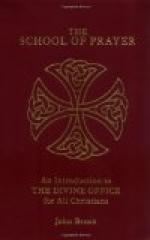Feast of All Souls, “The theological basis for the feast is the doctrine that the souls, which, on departing from the body are not perfectly cleansed from venial sins, or have not fully atoned for past transgressions, are debarred from the Beatific Vision, and that the faithful on earth can help them by prayers, almsdeeds, and especially by the holy sacrifice of the Mass. In the early days of Christianity the names of the departed brethren were entered in the diptychs. Later, in the sixth century, it was customary in Benedictine monasteries to hold a commemoration of the deceased members at Whitsuntide, In Spain, there was such a day before Sexagesima or before Pentecost, at the time of St. Isidore (d. 636). In Germany, there existed (according to the testimony of Widukind, Abbot of Corvey, c. 980) a time-honoured ceremony of praying for the dead on 1st October. This was accepted and sanctified by the Church” (Cath. Ency., art. “All Souls").
The psalms and lessons of this Office are especially well chosen, and the responses to the lessons—said to be the work of Maurice de Sully (d. 1196)—are greatly admired by liturgical experts.
It may be noted here, that, in the recitation of this Office, which is, for most priests, the only choral recitation of liturgy, care should be taken to select the proper nocturn or nocturns. “In the general rubrics of the Breviary (Tit. XIX. n. 2) it is stated that the invitatory is not to be said in Officio Defunctorum per annum, excepto die Commemorationis omnium fidelium defunctorum, ac in die obitus seu depositionis defuncti et quandocunque dicuntur tres nocturni. When, therefore, only one nocturn is recited, the invitatory is to be omitted except on the dies obitus seu depositionis.” In this latter case, even though the body is not present—for some special reason, such as contagious disease—the invitatory is not to be omitted.
“On any other occasion, no matter how solemn or privileged, such as the seventh, thirtieth, or anniversary day, when only one nocturn is recited, the invitatory must not be included. This is clear, not only from the rubrics of the Breviary and Ritual (Tit. VI., cap. IV.) but also from certain answers of the Congregation of Rites” (Irish Eccles. Record, December, 1913).




